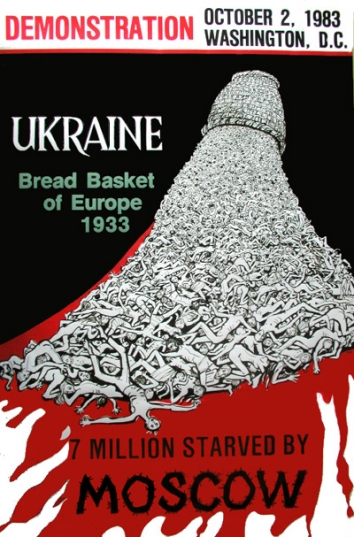Featured Galleries USUBC COLLECTION OF OVER 160 UKRAINE HISTORIC NEWS PHOTOGRAPHS 1918-1997
 Holodomor Posters
Holodomor Posters

IFC INSIGHTS
Ukraine’s Railway Reform May Attract Investment
.jpg) IFC, Kyiv, Ukraine,
IFC, Kyiv, Ukraine,
Oct 08, Thu, 2020
By David Lawrence
For several years, levels of foreign investment in Ukraine have remained far lower than a decade ago. Many potential private sector investors watched from the sidelines to gauge whether their perceived risks would lessen over time—enough so to take advantage of obvious opportunities in a country of 41.8 million people.
Foreign direct investment, or FDI, “is still at a trickle,” said IFC’s Country Manager, Jason Pellmar. “In 2012, Ukraine was pulling in $7 to 8 billion in investments per annum. But now, we’re talking about FDI of $2 billion per annum in a $150 billion economy. Now we need to get the country back on the investment radar screen.”
The country’s railroads are one area ripe for reform that could start to attract investment.
Ukraine’s railway company (Ukrzaliznytsia, or Ukrainian Railways) is essential for getting the country’s key exports—agricultural products, metals, machinery, and ores—to international markets. However, nearly 30 years after Ukrainian independence, Ukrainian Railways remains a state-owned monopoly with an outdated level of service and highly depreciated infrastructure and rolling stock. According to many observers, the quality and reliability of the company’s services could be significantly improved.
The current government is planning to restructure and modernize Ukrainian Railways, an effort that could include partial privatization. These efforts could potentially scale up the country’s exports, improve competitiveness, and strengthen Ukraine’s links to Europe’s logistics network.
Looking Upstream
In June, IFC and the World Bank identified export transportation—including railways and inland waterways—as one of three promising sectors (along with irrigation and non-performing loan resolution) that could benefit from its upstream work. Upstream projects are characterized by proactive action to develop bankable projects that attract investors.
Restructuring Ukraine Railways presents an important upstream opportunity. The World Bank has been working with the government on legal and regulatory reforms that will allow the company to be broken into separate entities—for example, cargo, passenger rail services, infrastructure, and maintenance. IFC can support these reform efforts by exploring investment opportunities, mapping potential private sector players, and providing technical support.
IFC and World Bank infrastructure experts say that investment potential in export infrastructure, including roads, is significant—as much as $30 billion. With successful reforms, the private sector could potentially make further investments in the sector, for example, in freight terminals and locomotives.
Ukrainian Railways is a significant player in the country’s economy, accounting for 2.6 percent of the country’s GDP. The company is essential for enabling many of Ukraine’s exports, which totaled $44.6 billion in 2019. Ore accounts for 38 percent of goods exported by rail, followed by grain at 31 percent.
The company controls virtually all aspects of the country’s railway system, including passenger transport, freight, railway stations (and shops located within them), railcar manufacturing facilities, and over 20,000 kilometers of tracks. It is divided into six regional railway companies, and controls numerous assets including locomotives, road-to-rail terminals, and other intermodal infrastructure.

Passenger trains in Truskavets, a resort town in western Ukraine. The new passenger trains (right), produced by South Korea, were introduced in 2012.
Some experts believe that one way forward for Ukrainian Railways is to focus on different oversight responsibilities instead of directly operating the rail business. This could include working on operating standards, technical policy, safety, tariffs, and certification.
“Ukrainian Railways is a very important entity in Ukraine, but it needs eventually to get out of commercial freight railway operations,” said Eric Luhmann, a railway industry expert based in Kyiv. “There are things Ukrainian Railways needs to continue to do and can do successfully and efficiently, but without competing with the private sector.”
On Track for the Future
Sevki Acuner, chairman of the Supervisory Board of Ukrainian Railways, identified several prerequisites for transforming the Ukrainian Railways. These include a comprehensive, transparent legal and regulatory framework; a detailed cost analysis, including long-term capital and development costs; sustainable labor and operational efficiencies, and government support for providing passenger services—a costly public service obligation. These initiatives will help provide both Ukrainian Railways and private sector competitors with fair and equal access to the railway system, ensure asset quality and safety measures, and will also better position the company in a competitive market.
The World Bank is supporting the government’s reform efforts in the sector. If successful, legislative reform, restructuring, and unbundling could pave the way for the creation of a cargo and logistics company. Restructuring could also open the door to private players in locomotives, which are in short supply. The passenger transport business would need government support, as in other countries.
IFC estimates that private sector opportunities in locomotives and rolling stock could be as high as $260 million. Potential investment in passenger train station concessions is also significant—up to $120 million annually. Local manufacturing of rail cars and locomotives could also attract investment. There are additional investment opportunities in modernizing railway infrastructure and optimizing operations.
These opportunities could take years to materialize, but the entire Ukrainian economy stands to benefit from the successful reform of Ukrainian Railways.
“For Ukraine’s export-driven economy, which is still based on natural resources and agriculture, a well- functioning rail transportation system that is integrated into the broader logistical system of the country is crucial,” said Acuner. “That is why the success of these reforms and the transformation of Ukrzaliznytsia is so important.”











